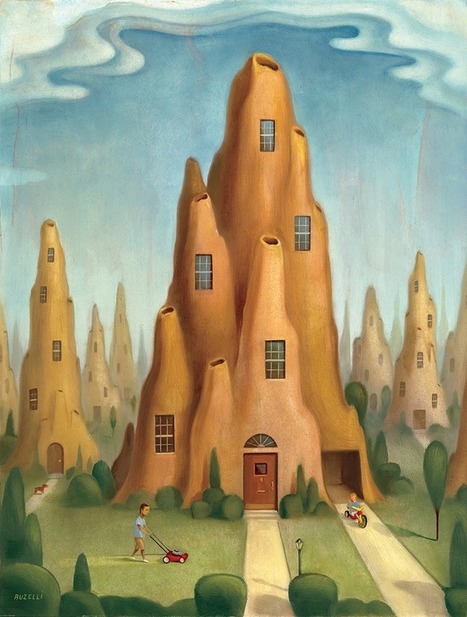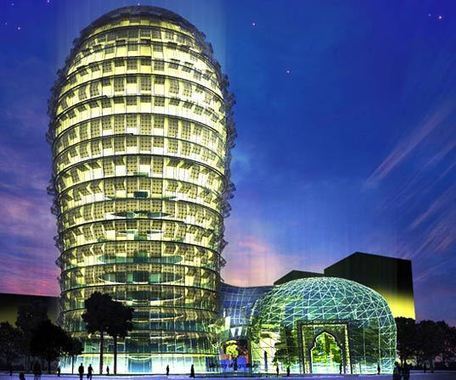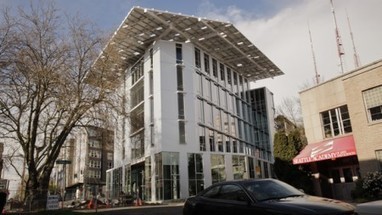 Your new post is loading...
 Your new post is loading...
With balconies budding like leaves, no one could complain for lack of outdoor space in this building in France.
"[...] the ‘polar bear pavilion’ is a prototype of a textile membrane structure, which offers new energy saving solutions for human habitations. The name says it all – despite the fact it is not intended for them, the inspiration for the outer layer of the building came from polar bears. “We came across the polar bear principle when we were studying older bionics books from the 1980s and decided to use it for our work on textile membrane structures. Rather than copying it directly, we studied the physical properties of polar bear skin and used other materials to imitate it,” said project leader Dr. Thomas Stegmaier of the Institute of Textile Technology and Process Engineering (ITV) in Denkendorf. " Photo details: Polar Bear (Sow) , Kaktovik, Barter Island, Alaska. Copyright © 2007, Alan D. Wilson. http://www.naturespicsonline.com
"Technically speaking, the smart facade-or building envelope that adapts to environmental conditions-dates back to the first window. But the contemporary idea of the smart facade has only been around for a few short decades, helped along by recent advances in chemical and material science. And over the past three years, we've seen the category boom. Below, check out some of the most interesting building facades to come across the screen in recent years: From a thermal metal screen that curls up when it's hot, to a titanium dioxide-covered wall that scrubs the air of pollutants."
Rather than simply aping nature's physical appearance, architects and designers are finding inspiration and potential revenue streams by studying nature's systems and materials.
"We used the biological influences of this specific place in Hawaii as the guiding principles for the architecture, building systems and overall experience. Hydronic passive cooling and ventilation supported by a seawater well, natural daylighting and the absence of mechanical fans all support a high-performance design based on the ecology of the Pacific."
"Architets have long taken inspiration from nature. In ancient Egypt columns were modelled on palm trees and lotus plants, and building designers have borrowed the shapes and proportions of natural forms ever since as they strived to achieve aesthetic perfection. Some architects now believe that such biomimicry has more to offer than simply making buildings look good. They are copying functional systems found in nature to provide cooling, generate energy and even to desalinate water. And they insist that doing these things using biomimetic designs is not just a gimmick, but makes financial sense."
"A 15-unit apartment building has been constructed in the German city of Hamburg that has 129 algae filled louvered tanks hanging over the exterior of the south-east and south-west sides of the building—making it the first in the world to be powered exclusively by algae. Designed by Arup, SSC Strategic Science Consultants and Splitterwerk Architects, and named the Bio Intelligent Quotient (BIQ) House, the building demonstrates the ability to use algae as a way to heat and cool large buildings."
Though scientists like USC’s Behrokh Khoshnevis and Enrico Dini are edging ever closer to developing a 3-D printer large enough to print houses, the technology is still a long way from being widely implementable.That hasn’t stopped architects from designing for it, though--after all, plenty of great architecture is unbuildable. A London design studio called Softkill is leading the way, painting a far-out picture of what 3-D printed architecture could eventually look like. At last week’s 3D Printshow, the team of Architectural Association grads presented a concept called ProtoHome, which imagines a radical new mode of construction based on the strengths of 3-D printing. Their design is in stark contrast to other 3-D printed home schemes, which are either markedly utilitarian or oddly traditional. The spindly, web-like structure is based on an algorithm that mimics the way bones grow in human bodies. It directs extra material to the points of greatest stress within the home, and tells them to form stronger bonds in those spots--hence the rabbit’s warren of micro-columns that form under the home’s long cantilevered deck.
Architects love saying their buildings have brains. Now, apparently, they've got brawn, too. The latest intelligent-building tech from New York architects Decker Yeadon is a mighty, muscle-y structural facade that fights solar heat-gain by flexing its guns.
From New York City-based architects HWKN’s Matthias Hollwich and Marc Kushner comes Skygrove: a one million-square-foot design concept for a commercial office building that operates in a wetter world. [...] The Skygrove concept was created to visualize what architecture might look like in an era of rising seas, not only to protect tenants from their implications but to “capitalize on their potential.” Skygrove’s architecture is, of course, biophilic: its lower floors mimic the roots of a tree growing in a tidal location. Each floor in Skygrove is self-sufficient and “designed for independent survival in a maximum disaster,” connected by a compartmentalized facade with the tower’s necessary infrastructure: vertical circulation, water, energy, and air supply.
Imitating nature has become a meaningful approach for contemporary architects and design futurists to the built environment, especially for those who foster a future that doesn’t compete with nature but coexist with it. At the light of recent natural disasters around the world, especially those geologically associated such as tsunamis and earthquakes, which have proven its destruction power over the current built environment; architects and structural engineers have found in biomimicry an ecological approach in order to improve future building’s disaster resilience
It doesn’t take much to be considered smart if you’re a building. Add some lights that turn themselves off when nobody is around or install an “intelligent” air conditioning system to regulate the ambient temperature and you’re well on your way. But compared to the living buildings proposed by Akira Mita, today’s smart buildings are the architectural equivalent of single-celled organisms.
Recent earthquakes around the world have pushed engineering and architect to rethink and redevelop new strategies to reinforce concrete structures. Architect Wilfredo Mendez, is analyzing how bio-adapted structure made of concrete will behave when influenced by seismic forces. Mendez initial thoughts and conclusions have determined that concrete structures could be simulated and compared with the human femur bone. His design has been based on 'force-driven morphology, mechanical resilience and environmental adaptation'. Check also: http://construction.about.com/b/2012/04/22/biotechnology-improving-buildings-earthquake-resistance.htm
|
"In 1991, the multinational Old Mutual investment group approached the Zimbabwean architect Mick Pearce with an audacious assignment. The group wished to construct a retail and office complex called the Eastgate Centre in Zimbabwe’s capital city of Harare that, at 55,000 square meters, would be the country’s largest commercial building. What Old Mutual didn’t wish to do was pay the high cost of air-conditioning such a massive space. Could Pearce, working with the Arup construction firm, devise a design that relied solely on passive, natural climate control? Pondering the problem, Pearce found inspiration in the termite mounds that dotted the savannas across his country. "
"The Minister of Municipal Affairs & Agriculture (MMAA) in Qatar is getting a brand new office building that takes the form of a towering cactus. Designed by Bangkok-based Aesthetics Architects, the modern office and adjoining botanical dome take cues from cacti and the way that they successfully survive in hot, dry environments."
"It’s nearly 100 feet tall, fed by the sun and rain that fall on it, and is composed largely of wood. But it’s not a tree. It’s the world’s greenest office building. The Bullitt Center, finished in the summer of 2013 and located on the edge of Seattle’s downtown, is designed to mimic the Douglas fir forests that once stood on the site."
"When the pope said Mass there this fall, the Sagrada Família was already 128 years in the making—and still not finished. Yet the church’s nature-inspired design remains ahead of its time."
"The philosopher Eric Hoffer once said, “Creativity is the ability to introduce order into the randomness of nature.” This outlook parallels historic attitudes toward the relationship of the made versus the born. The contrasting view—that nature is the source of creativity—is now gaining strength. Biomimicry, which advocates nature as a design mentor rather than a source for raw materials, has influenced many fields and taken form in strategies ranging from metaphorical to manipulative."
"Researchers are investigating how termite mounds can be used to shape future buildings which feature walls that breathe as part of a major new international study involving Nottingham Trent University (UK). The $1.35millon project will examine how the unique structure of the termite mound enables stale and fresh air to be exchanged while maintaining a comfortable level of temperature. Described as a lung by the researchers, the termite mound is the only habitat known in the animal kingdom to have been proven to exchange oxygen and carbon dioxide without losing heat, which enables termites to live in harsh climates they could not otherwise inhabit. One of the ultimate aims of the project is to create buildings which feature walls that breathe in the same way and reduce the need for central heating or air conditioning."
As seas rise, some architects suggest, the next generation of waterfront designs should draw inspiration from the intricate ways that plants and animals have adapted to their situations.
The Eastgate Centre in Harare, Zimbabwe, typifies the best of green architecture and ecologically sensitive adaptation. The country’s largest office and shopping complex is an architectural marvel in its use of biomimicry principles. The mid-rise building, designed by architect Mick Pearce in conjunction with engineers at Arup Associates, has no conventional air-conditioning or heating, yet stays regulated year round with dramatically less energy consumption using design methods inspired by indigenous Zimbabwean masonry and the self-cooling mounds of African termites!
Now no one can say butterflies are all style and no substance. This might look like a pretty lily pad but it is actually a wafer created with lasers to mimic the iridescent colours of a butterfly's wings. For extra credit, Shu Yang at the University of Pennsylvania in Philadelphia, who led the project, also made the wafer water-repellent - another property of butterflies' wings, which helps them fly through rain.
The cellular Shadow Pavilion is the result of simple materials lightly manipulated and connected to dramatic effect. More than one hundred aluminum sheets, laser cut and rolled into cones of various sizes are attached in pre-assembled clusters from offsite. The lowest row buried in the soil of Matthaei Botanical Gardens, Ann Arbor, Michigan anchors the project. PLY Architecture developed the self supporting structure using software modeling to determine shadow patterns, material efficiencies, geometric tethering and assembly.
The focus of meticulous assembly disperses as the pavilion becomes land art, both reflecting and manipulating its surroundings. The design strategy is based on phyllotaxis, the pattern which forms on many flowers and cacti as successive layers of petals, leaves or nodules grow to form a spiral. The interior’s funneled light and water create a micro-environment inside.
Can you spot nature in these architectural designs?
Project Haiti Orphanage and Children's Center is about the people of Haiti who are facing ongoing devastation following the earthquake of January 2010. It's about a replicable, RESILIENT model for rebuilding and it's not surprising that the USGBC, HOK and Lend Lease are utilizing the principles of Biomimicry to inspire the design.
|
 Your new post is loading...
Your new post is loading...
 Your new post is loading...
Your new post is loading...


































No words needed ...